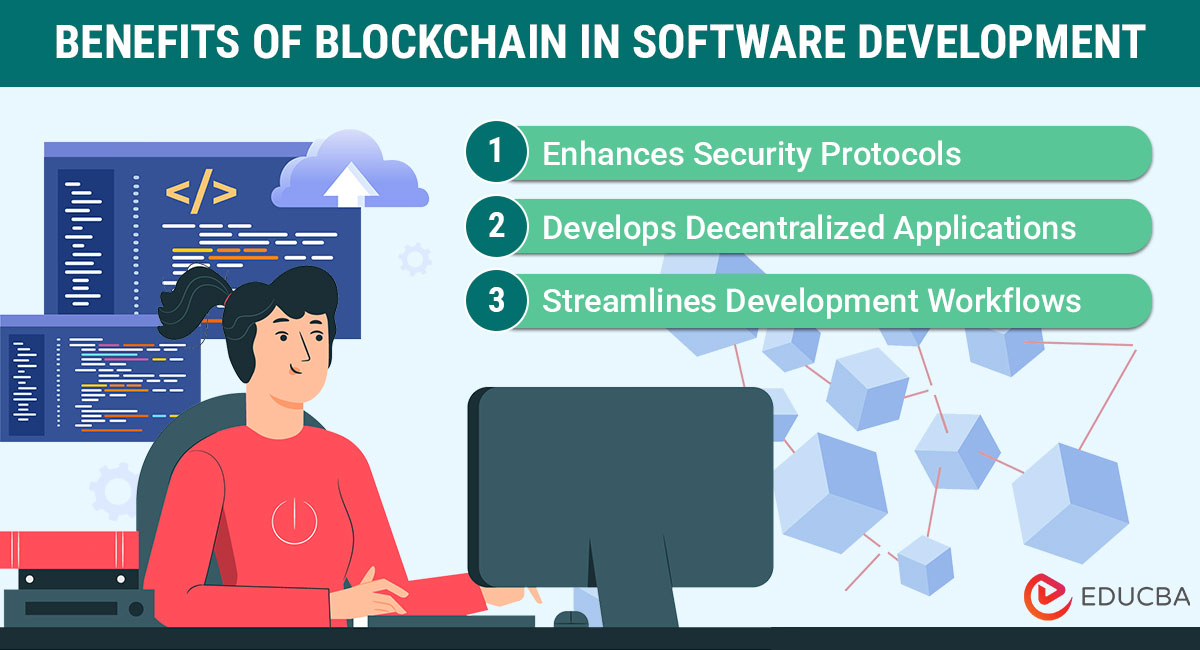Introduction to Blockchain in Software Development
Blockchain was first made for cryptocurrencies like Bitcoin, but now it is used for much more than that. Nowadays, it stands as a transformative force across various industries, and one of the most significantly impacted areas is software development. With its decentralized architecture, enhanced security, and transparent processes, blockchain reshapes how software is created, deployed, and maintained. In this article, we explore how blockchain in software development is driving innovation, streamlining workflows, and overcoming long-standing challenges.
Understanding Blockchain Technology
Blockchain is a digital record book that stores transaction activities across many computers without relying on a central authority. Once someone makes a data entry, it stays unchanged and becomes visible to all participants. Each block holds a list of transactions and links to the previous block through cryptographic hashes, forming a secure chain of information.
Key features that make blockchain valuable in software development include:
- Decentralization: Eliminates a single point of failure and increases system resilience.
- Immutability: Ensures that once written data cannot be altered or deleted.
- Transparency: Promotes trust by making data accessible and verifiable.
- Security: Uses advanced cryptographic techniques to prevent unauthorized access or modifications.
- Smart Contracts: Self-executing contracts with terms directly written into code, enabling automatic and trustless transactions.
Key Benefits of Blockchain in Software Development
1. Enhances Security Protocols
Security is a cornerstone of any software project. Blockchain’s decentralized and cryptographic nature provides a robust framework for secure development.
- Data integrity: Blockchain ensures that data, once entered, cannot be changed. This protects against data tampering and unauthorized edits.
- Decentralized authentication: Eliminates reliance on a central server, reducing vulnerability to attacks like DDoS.
- Secure software distribution: Updates and patches can be distributed over the blockchain, ensuring only verified code reaches users.
2. Develops Decentralized Applications (DApps)
Blockchain is great for creating decentralized apps (DApps) that run on peer-to-peer networks instead of relying on central servers.
- Reduced Downtime: DApps are less prone to outages and disruptions.
- User Empowerment: Users maintain greater control over their data and digital identities.
- New Business Models: Token economies and reward systems can be integrated directly into DApps to incentivize user engagement.
3. Streamlines Development Workflows
Incorporating blockchain into custom software development services can enhance efficiency and transparency in development workflows.
- Decentralized Version Control: Keeps an immutable record of all code changes, improving collaboration and accountability.
- Smart Contract Automation: Automates processes like CI/CD pipelines, reducing manual intervention and error.
- Audit Trails: Blockchain provides a transparent log of changes and actions, aiding compliance and simplifying audits.
Applications of Blockchain in Software Development
1. Intellectual Property and Licensing
One of the critical concerns in software development is protecting intellectual property (IP). Blockchain provides:
- Proof of Ownership: Developers can timestamp their code on the blockchain, offering verifiable evidence of authorship.
- Smart Licensing: Automates and enforces software licenses through smart contracts, which are useful for CRM systems and SaaS products. Explore CRM software examples that use blockchain for licensing automation.
- Royalty Management: Automatically distributes royalties to developers based on software usage and licensing terms.
2. Supply Chain Transparency in Software Projects
Modern software often depends on multiple third-party components. Blockchain brings transparency to the software supply chain.
- Traceability: Maintains a verifiable history of software components, ensuring they come from trusted sources.
- License Compliance: Tracks open-source licenses and enforces compliance, reducing legal risks.
- Vulnerability Management: Keeps a transparent record of known vulnerabilities in third-party modules.
3. Cost Efficiency
Integrating blockchain in software development can lead to long-term cost savings.
- Reduced Intermediaries: Smart contracts remove the need for middlemen or third-party approval.
- Optimized Resources: Decentralized networks can lower infrastructure costs using shared computing power.
- Fraud Prevention: Blockchain’s transparency and traceability reduce the likelihood and cost of fraud.
Challenges of Using Blockchain in Software Development
Despite its benefits, blockchain integration comes with challenges:
- Scalability Issues: Public blockchains like Ethereum can process limited transactions per second, leading to latency.
- Energy Consumption: Consensus mechanisms like Proof of Work (PoW) consume substantial energy, though alternatives like Proof of Stake (PoS) are emerging.
- Regulatory Uncertainty: Global blockchain laws and regulations are still evolving, creating potential compliance risks.
- Talent Shortage: Skilled blockchain developers are scarce, making hiring and training difficult.
Future Outlook of Blockchain in Software Development
The future looks promising for blockchain in software development. Advancements in blockchain protocols and tools are addressing existing limitations. Proof of Stake and other eco-friendly consensus models reduce energy consumption, while layer-2 solutions help with scalability.
Meanwhile, developer communities are growing, and educational resources are becoming more accessible. New platforms and frameworks are simplifying blockchain integration into mainstream development workflows.
Final Thoughts
The impact of blockchain in software development is undeniable. From secure data handling and smart automation to user-centric application models, blockchain is transforming the very foundation of software development and maintenance. While challenges like scalability and regulation exist, continuous innovation is paving the way for broader adoption.
For developers, product managers, and tech leaders, embracing blockchain is about staying current and building secure, transparent, and future-ready software. As tools mature and best practices evolve, blockchain will undoubtedly play a central role in the next generation of digital solutions.
Recommended Articles
We hope this article gave you a clear view of how blockchain is reshaping software development. Explore these recommended articles to learn more about smart contracts, DApps, and building secure, decentralized solutions.

